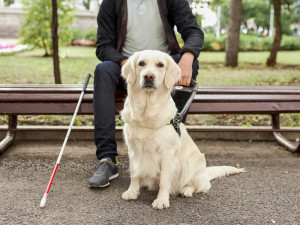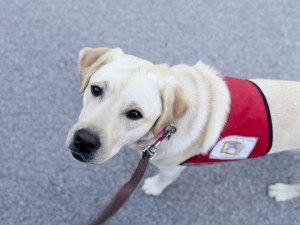You Can’t Fly With Your Your ESA, But Your PSD Is Welcome on a Plane
Find out how here, including what the heck those acronyms mean.

share article

Your pet wants you to read our newsletter. (Then give them a treat.)
In December 2020, after years of mid-air animal chaos, the Department of Transportation (DOT) announced it was revising the Air Carrier Access Actopens in a new tab. No more claiming your incontinent pigopens in a new tab, jet-setting marmosetopens in a new tab, or therapy turkeyopens in a new tab as an “emotional service animal.” Now, the only kind of service animal the DOT recognized would be “a dog that is individually trained to do work or perform tasks for the benefit of a patient with a disability.”
The news came as a relief to many in the airline industry, who had found themselves regularly having to act as high-altitude zoo-keepers. “The days of Noah’s Ark in the air are hopefully coming to an end,” Sara Nelson, the president of the Association of Flight Attendants told USA Todayopens in a new tab at the time, adding that several of her colleagues had been injured by uncooperative animals.
But for many Americans, traveling with an animal is essential for their health. This includes passengers with hearing and sight impairments, but also those with mental health illnesses such as depression, anxiety, PTSD, and conditions including agoraphobia or claustrophobia. In these cases, passengers can travel with what is known as a Psychiatric Service Dog (PSD).
Unlike emotional support animals (ESAs) PSDs must be dogs, and they require specific training to perform certain tasks based on their owner’s unique psychiatric needs. For those who need the support, a PSD can be “life-changing,” says Debi Krakar, the founder of the Texas non-profit organization Dog Allianceopens in a new tab in Texas, which provides service dogs for qualified veterans.
So what do PSDs do, exactly? Who can they help? Here’s what to know:
What are PSDs?
Psychiatric service dogs are service dogs like any other, only instead of being trained to work with individuals with physical disabilities, they’re trained to work with individuals with certain kinds of mental illnesses. Under the Americans with Disabilities Act (ADA), service dogs have full public access rights, meaning they’re allowed to accompany their owners into spaces where dogs aren’t usually welcome.
What differentiates a PSD from an ESA is training. Any domestic animal can become an ESA, and it doesn’t require any training. Their role is to offer comfort to their owner during potentially stressful situations. A PSD is a dog that has received extensive training to work with the specific needs of their owner. PSDs are also different than the therapy dogs you might see greeting people in hospitals or nursing homes.
Though many therapy dogs do receive training, unlike PSDs, they are trained to bring comfort to many people, including strangers, and are not trained to meet the needs of one specific person. Therapy dogs don’t have the same public access rights as service dogs.
Who can PSAs help and how?
PSDs have been trained to help individuals with a number of conditions, including PTSD, depression, anxiety, bipolar disorder, schizophrenia, obsessive-compulsive disorder, and social phobias.
How exactly they help depends on their owner’s individual needs. PSDs have been trained to remind their owners to take their medication, and retrieve the medication themselves if their owner is unable to move. They can also help wake their owners out of night terrors, and provide therapeutic or tactile distraction for individuals who are about to suffer a panic attack, or balance assistance for those whose medication can result in lethargy, dizziness, or confusion.
“A lot of times, our clients are fearful of being in crowds, or of someone coming up behind them,” Krakar said. “We can teach the dog to do a down, and stay behind them in a line. So the dog isn’t growling, it’s not protecting that individual, but it’s providing that space that allows an individual with anxiety to be out in public.”
How does a dog get certified as a PSD?
Individuals interested in a PSD have a few options: if they already have a dog, they can train it to be a PSD themselves, or they can hire a trainer to help them. They can also apply to adopt a dog that has been bred and trained by an organization like the Dog Alliance.
Krakar noted that, although people may want the dog they already love and have an emotional connection with to serve as their PSD, not all dogs are suited for it. Telling people their beloved pup can’t be their service dog is the “hardest thing we do,” she said.
At the Dog Alliance, dogs are trained for a minimum of 18 months before they’re matched with a potential owner. During this time, the dog is taught to behave in crowded and occasionally chaotic public spaces. “Like HEB the day before Thanksgiving,” Krakar laughed, referencing the popular Texas grocery store chain. Service dogs have to be able to stay calm and focused on their owner even if another dog is barking at them, or other people are getting in their space. “For us, we can’t certify them as a service dog unless they’re perfect out in public,” Krakar says.
Once the dogs have a base-level of obedience, Krakar and her team get to know each client, match them with a dog that seems like a good fit based on its strengths and temperament, and then tailor the remaining months of training to that owner’s specific needs.
It’s a long and involved process, but demand is high. Krakar said the Dog Alliance gets roughly 20 calls a day from individuals interested in getting a service dog. Though awareness of the different types of service dogs is growing, Krakar says there is still a lot of misunderstanding and insensitivity out there.
“Sometimes you get comments like, ‘Oh, you’re so lucky you get to have your service dog with you.’ I think people should bear in mind that nobody chooses to have a mental illness that’s so severe that they need a service dog,” she said. “You’ve got to respect them. Respect their space. They don’t want to answer questions about why they have that dog all the time. The dog is there because it’s needed for a disability.”

Madeleine Aggeler
Madeleine Aggeler is a freelance journalist and copywriter in Washington, D.C. Previously, she was a writer at New York magazine’s The Cut. She lives with her dog, Cleo, who works primarily as a foot warmer.



